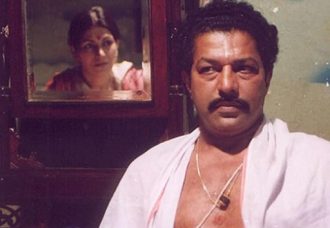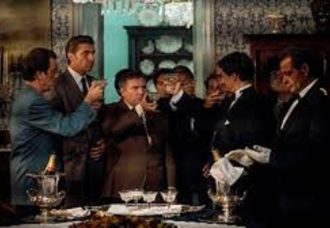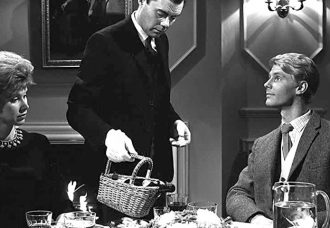The Cabin in the Woods
Although The Cabin in the Woods is nominally a teen horror film in the mold of Sam Raimi’s The Evil Dead (1981), it not only uses another kind of narrative – perhaps consciously derived from The Truman Show (1998) – to frame itself but also invokes whole sub-categories from the horror genre to assume the shape of a quiz or puzzle for film buffs.
The teen horror story part of the film revolves around five young people who go off on a picnic to a cabin somewhere in the mountains. At the last gas stop before their destination, a decrepit old man mumbles that it will be easier for them to reach the cottage than get back but they ignore the dire warnings and proceed. The cottage is idyllic but it is still a sinister place. There is a horrible painting on one of the walls which shows a slaughtered animal being carved up in the woods by mountain men, with dogs fighting for pieces of the carcass. The picture is so unsettling that Holden in whose room it hangs takes it down, only to find that it conceals a one-way window into the next room occupied by a Dana, who only sees it as a mirror. Holden resists the urge to spy on Dana as she undresses and this becomes the basis of their attachment for each other.
Dana is innocent (‘nearly a virgin’) while Holden is an egghead. The other three are the athletic Curt and his sluttish girlfriend Jules and the pot-smoking weirdo Marty. It has become evident by this time that the characters are conceived as the standard youthful stereotypes from the picnic-to-horror sub-genre – films ranging from the Evil Dead films, the Friday the 13th series to Lake Placid (1999) in which the horrific element is not supernatural but reptilian. The highpoint of this thread in the film is a ‘truth or dare’ game in which Jules is given the penalty of ‘making out’ – with the snarling head of a timber wolf mounted on a wall. This ‘seduction’ of the wolf by Jules is probably the best segment of the film because it is perched on the edge of sexual transgression – an element central to teen horror as a genre. One might even imagine Little Red Riding Hood as a horror tale softened for a child’s palate.
What has just been related may make The Cabin in the Woods seem even frightening but each sequence in this story is cut to one in the second thread which reduces all this to near jest. The film actually begins with two technicians discussing a project and it gradually emerges that they are executives in a reality show and that they are actually controlling everything in the horror story. For instance, Jules and Curt walk out into the night and the technicians release pheromones into the air in order to arouse them sexually. The technicians also open a trap door in the floor of the cabin and the five are led into a basement. In the basement the five discover several artifacts one of which is a hillbilly chronicle from which one of them reads out a passage from 1903. It comes out now that the five might have chosen any of the artifacts and each one would have led them to a different horror scenario.
The reading out of the chronicle – and the spell embedded in it – becomes a cue for the technicians to let loose a family of zombie hillbillies (‘the Bruckners’) who are bent on murder. The first to be killed is Jules and the next is Holden. When Curt attempts to drive them all back, the technicians activate a landslide which buries the tunnel out of which they might have made their escape. Curt himself is killed when he tries to jump his motorcycle over a chasm and comes into contact with the invisible electric shield which keeps the reality show space apart from the rest of the world. Marty is presumed killed by the technicians but he has discovered the whole scheme and even the elevator below the cottage which takes Dana and him inside the control apparatus. This is when the technicians gradually lose control and a whole range of monsters like vampires, zombies, werewolves, giant bats and sharks – from various horror genres – are let loose. Dana and Marty find a crypt/temple and as the technicians are losing the battle, their ‘Director’ (Sigourney Weaver) makes an appearance and reveals all.
According to the scenario devised by the technicians, the five were all to die one by one, all except ‘the Virgin’ Dana who could choose to live. The scenario is an elaborate ritual devised to appease the ‘Ancient Ones’ living deep underneath and Marty’s discovery of the apparatus has ruined everything. The Director now appeals to the two to allow Marty to be sacrificed before sunrise. Either he dies alone and the world will be saved or he will die along with everyone else. But the Director herself falls into a crevice towards those she is seeking to appease. The film concludes with Marty and Dana still alive next morning when a gigantic hand belonging to an ‘Ancient One’ comes up out of the earth, presumably to destroy mankind.
While The Cabin in the Woods has been widely praised, it has also generated a bit of dissatisfaction. The chief one is that alternating between the five young people and technicians who control their fate leaves the film pretty much without a frightening element. While this is certainly true, the malaise of the film perhaps runs much deeper than film critics will allow. The primary horror in the film is expected to ride on the zombies called the Bruckners but they are themselves the creations of the technicians. The horror in the horror film, I propose, does not come out of the violence inflicted on the victims. One would not, for instance, associate ‘horror’ with a film in which a mechanical man runs amok and hacks people to bits. The emotion, I suggest, comes out of our sense that there is still something deeply incomprehensible about the world which might eventually threaten us – our own dead rising up with a thirst for blood, men having their teeth turned into fangs and their hands into claws.
One way in which this is done is to suggest a passage of time during which the horrific object ‘matures’ – the mother dead and buried years ago in Psycho (1960) or the Indian burial mound on the site of the hotel in Kubrick’s The Shining (1980). The Cabin in the Woods, similarly, invokes a hillbilly family from more than a century ago which practiced black deeds but quickly turns them into ‘creations’ of a reality show. In its cleverness, it makes these horrific objects synthetic and manageable. It is like showing someone a rotting corpse and then revealing that it is made of plastic. Even if the ‘corpse’ comes murderously to life thereafter, it would be of little avail.
The Cabin in the Woods may be designed as a puzzle for horror film buffs (Roger Ebert wonders if it is a piece of ‘criticism’) but in the process of doing this, it robs horror of its metaphysics. Horror, like wonder, depends on an admission of incomprehension. If nearly everything in The Cabin in the Woods is eventually shown to be make believe, the one ‘truth’ at its heart are the ‘Ancient Ones’ living underground and needing appeasement. This is a motif taken from HP Lovecraft (1890-1937), perhaps America’s greatest horror writer after Edgar Allan Poe. Lovecraft invented ‘Cthulhu’ an ancient malevolent being from another planet, who settled on Earth long before mankind, has been slumbering underground ever since then and is a constant anxiety for mankind at the subconscious level. In The Cabin in the Woods the malevolent ‘Ancient Ones’ live in what looks like a crevice in the studio floor – a far cry from an unspeakable monster slumbering under the Earth’s crust. In the process of turning ‘horror’ into a puzzle for film students, therefore, the filmmaker has apparently domesticated the ‘unspeakable’. If The Cabin in the Woods is a celebration of the genre for students fascinated by its possibilities, it is akin to celebrating the possibilities of language through a crossword puzzle.
After all this has been said about The Cabin in the Woods, we may conclude with some speculation about the decline of the horror film in Hollywood. Some of the best American films developed on the genre – films like John Boorman’s Deliverance (1972), Hitchcock’s Psycho (1960), David Lynch’s Blue Velvet (1986) and Ridley Scott’s Alien(1979) – but all we have now are the kin of Scream (1996) and I know What you Did Last Summer (1997) in which an unidentified killer with doubtful motives mimics the ‘unknowable’. The sense to be increasingly got from Hollywood films today is that the world is physically knowable. This is clearly not because the advances in science have accomplished so much: the public which subscribes to Hollywood does not really ‘know’ but takes it on faith that science and technology have solved every riddle related to the world.
I had suggested in any earlier column that today’s fantasies with their emphasis on technology are placed in the grey area between what the public thinks plausible and what is fantastic with the dividing line between the two categories becoming increasingly blurred. I will extend the argument by saying that the ‘fantastic’ is not what is only in the realm of the imagination – as Dr Jekyl and Mr Hyde and The Time Machine are – but something the actualization of which has been deferred till tomorrow. It is in this context that the zombies from The Cabin in the Woods should be placed. They are no longer ‘fantastic’ beings arising out of our deepest anxieties about death and the afterlife but simply testify to what the reality show on television will achieve tomorrow.
<The above review originally appeared in Bikas Mishra‘s film publication, ‘Dear Cinema’>
The Cabin in the Woods on IMDB








